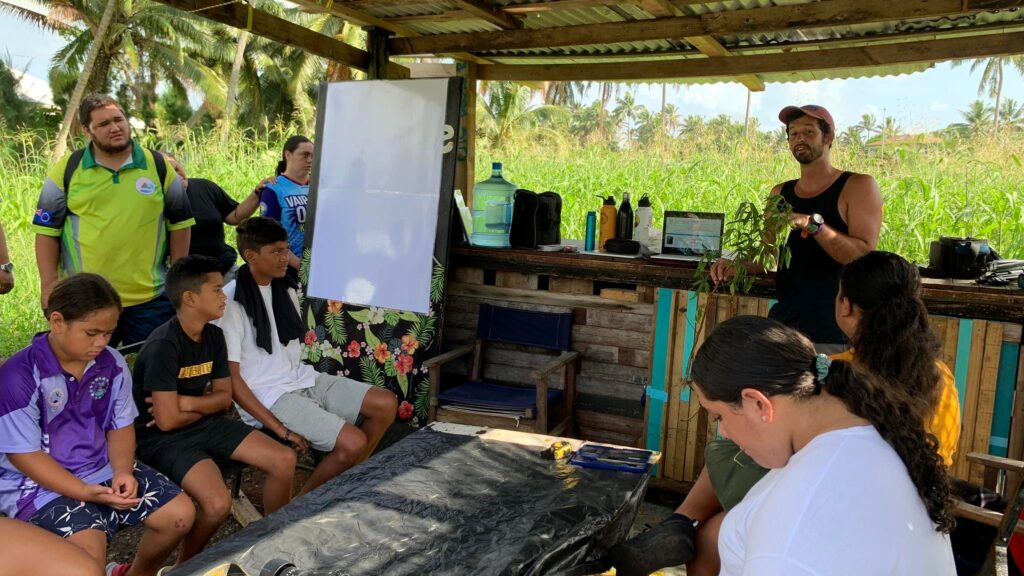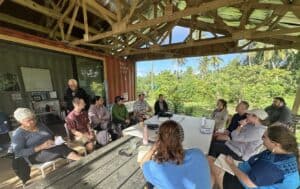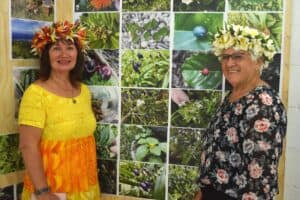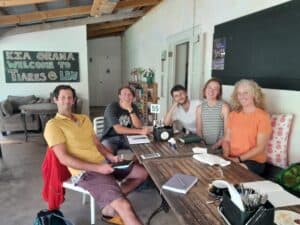Groups from different organisations came together to acknowledge the importance of our wetland environments. The participants represented Muri Environmental Care, Te Ipukarea Society, and training teachers from the Ministry of Education. All collaborated to conduct research based on three themes – plant life, insect life and water quality. The Youth Media Team were there to capture all the action to share and raise awareness.
Investigations conducted looked at what life lives in our wetland waterways, where insects such as dragonflies and damselflies live around our wetland waters as well as plants such as Tiemu, two types of wetland taro and water netting. An interesting point to note is names for these taro plant may differ from island to island, for example – Manaura Taro on Rarotonga is known as Taro Rakahanga on Rakahanga.
Young researchers had heaps of fun chasing dragonflies with nets and collected samples of plants, insects and water using numerous methods including; locating, collecting, measuring, mixing, identifying and photographing. Names of plants were entered into online sites to get their scientific name. Insect colours and characteristics were used to identify them against others online.
Testing the pH of soil was interesting to observe. Ara and Pipi, two keen young environmentalists conducted these tests. They added white vinegar to one sample and bubbles came up meaning the dirt was acidic. They added baking soda to the other and there was no reaction. A fizzing reaction means the soil has a basic alkaline pH level, and our wetlands need both for different organisms to thrive.

It was amazing seeing everyone enjoying themselves, laughing while researching and exploring topics that can sometimes be boring to learn about for youth. Especially as the young ones got the opportunity to really get involved and do the research themselves. There were hilarious moments watching the youth media team attempt to catch dragonflies themselves, only to capture one another in their nets!
Ecologist, Brennan Panzarella, who facilitated the event for Muri Environmental Care, said: “We had a blast getting to know one of Rarotonga’s many wetlands in greater detail. Through discovering and identifying species of plants and dragonflies in the wetland, we hope the attendees were left inspired by what they saw and experienced. We also played around with some scientific tools and ways of thinking.”
“Wetlands are important features in the landscape that provide numerous beneficial services for people, fish and wildlife. Some of these services or functions include protecting and improving water quality, providing fish and wildlife habitats, storing floodwaters and maintaining surface water flow during dry periods.”
Alanna Smith from Te Ipukarea Society said: “Te Ipukarea Society is a non-government environmental organisation formed to conserve and protect our heritage. Grass root engagement is an area TIS work closely in particularly in awareness raising as well as being a voice for the people.”
“Getting people to start caring for our wetlands will involve getting the people to understand the value wetlands provide us through ecosystem services (helping reduce floods, taking out nitrates before reaching our lagoon where they contribute to the yucky algae we are seeing today).
“Recognising this value and foreseeing the negative impacts our communities may face if we destroyed our wetlands may just flick a switch, where more people start to care, and more importantly want to protect them.”
MEC Youth Media member, Henare Tapuvae, 15, said: “I’ve learnt so much from this experience, that I wish for current and future generations to protect our wetlands and to protect our home. Keep an eye out for the footage from our youth media team.”
Without our wetlands, cities have to spend more money to treat water for their citizens, floods are more devastating to nearby communities, storm surges are displaced from hurricanes that can penetrate farther inland, animals are displaced or die out, and food supplies are disrupted, along with livelihood. They have so many benefits, they act as a natural filter. This slows the water down making it less likely to cause erosion. Climate change is also expected to impact wetlands due to change in temperature and the amount of precipitation.
We are a major threat to wetlands, and in Rarotonga our wetlands such as taro plantations, are just one of the things that we use to grow, harvest and live from. So what are you going to do to help protect our island and take good care of our environment? To support, go to Muri Environment Care and Te Ipukarea Society on Facebook and follow us, the Youth Media team. Join us on our journey to a better tomorrow!



